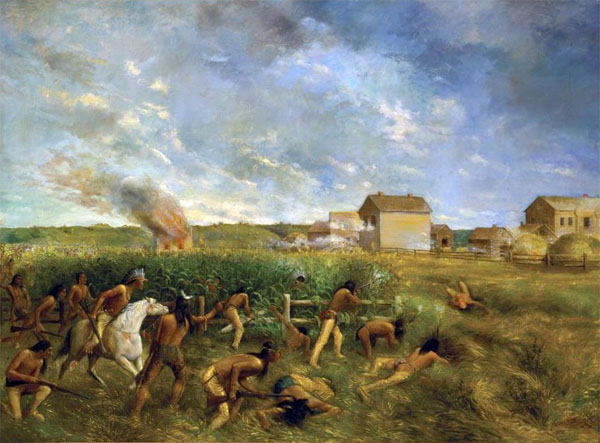Carl Leistico and Bride, Early Hutchinson Settlers, Driven Out by Red Savages
Their Home Was Burned and Their Stock Killed After They Had Fled to Hutchinson Stockade - Afterward
Located in Carver County
Back in the days before the
Indian outbreak of 1862 a young German immigrant, Carl Leistico by name, was working
in the Hutchinson community. In the same neighborhood there was a young German girl, Augusta Maschkie, who also had
come out from Germany a short time before. Naturally the common antecedents and interests of the pair drew them
together, and the maiden did not need much persuading to agree to become a bride.
They were married in Hutchinson
and began farming four miles east of town. The young husband had nothing but his empty hands and his loyal, capable
bride, which, after all, was a great deal. But he managed to get a yoke of oxen the second year and later five cows,
five sheep and seven hogs. This was a fine start in those days and undoubtedly the young couple were very happy.
One pictures them studying their growing crops on late summer evenings after their work was done, making plans for
the future and dreaming of ease and contentment in years to come.
Money was woefully scarce, but the young wife
spun the wool furnished by the sheep for clothing, and when there was enough produce to be marketed, the husband
went on foot to St. Paul, carrying supplies home on his broad back. The trip required a week and the young wife
kept lonely vigil at home, bravely facing many dangers. Indians were numerous and were steadily growing more
hostile.

1904 oil on canvas painting by Anton Gag "Attack on New Ulm". In the Dakota War of 1862,
the city was attacked twice by Dakota soldiers from nearby reservation on the Minnesota River to the west. Retreating
behind barricades that protected the city center, local citizens fought back, supported by volunteer militia who arrived
from other towns to support the city's defense.
But fate was soon to deal the young couple a severe blow. When they fled to the fort at Hutchinson before
the advancing Sioux in 1862, their home was burned and their stock killed. After the danger was past they returned
to their farm, but found only blackened ruins. Although all their hard work had been set at naught and they were left
destitute, they resolutely began again. This time they located in Carver County near Young America. Mr. Leistico,
however, went back to serve as a guard at the fort until his services no longer were needed. Then they started all
over again. The husband obtained a yoke of oxen from a neighbor, for which he paid in labor.
The new farm consisted
of 160 acres, all timber land. Mr. Leistico erected a cabin and began clearing the land. In the 18 years that the
couple lived on the place they cleared 100 acres. They forged steadily ahead and naturally became prominent residents
of the community. They were Lutherans and Mr. Leistico helped to build a Lutheran church in Young America.
In 1881 they
sold their Carver County farm and removed to Nobles County where they purchased a section of land. They erected a
comfortable home on the property and lived there 22 years. Then they moved to Lake Preston, Renville County, where
they bought 285 acres. They retained this property awhile and then sold it and returned to Worthington, Nobles County,
to reside, giving up active work.
Of their 10 children, one, Herman, was born in Hutchinson. Albert, Fred, Bertha,
Minnie, Tillie, Henry and Otto were born on the Carver County farm, and Emil and Edward, in Nobles County. Several of
the children became identified with this section and today the name is well known here, although it is commonly
spelled "Lestico". Records in the writer's possession show that Emil and Otto were in the mercantile business at
Stewart for some time. The activities of the sons in later years are too well-known to require mention here. Emil
still lives in Stewart and Otto in Hutchinson. Albert is a dentist in Gaylord.
It is generally conceded that the
herculean task of opening a farm in a frontier country is in itself a most formidable undertaking; but when the
results of years of effort are swept away at one stroke and a start must be made all over again, only those stout
of heart can go back again to the beginning and make a second attempt. For this reason the story of the career of
Mr. and Mrs. Leistico has a special appeal. Hundreds of settlers who fled at the time of the outbreak gave up in
despair. Others Look up the threads of the former lives only after several years. but the young couple with whom
we deal in this article lost no time.
The plundering Sioux had left them empty-handed, but they did not discourage
them. The first years on the Carver County farm must have been trying ones; it is probable that the pair often
thought ruefully of their earlier labors, but their pluck and energy soon produced results and the success of their
second venture proved that nothing could daunt them.
The result was that the children they brought into the world
fared far better than would have been the case had the parents been less capable. It would seem that these children
owe a great deal to their remarkable parents, and it is certain that this section is deeply indebted to the pioneer
couple. When stories of the heroism of the outbreak are told, the tale of the pluck and perseverence fo Carl
Leistico and his wife should not be overlooked. For very few Minnesota pioneers triumphed over greater obstacles
or faced more hardships than they. óMidland Feature Service.
If you have comments, corrections or additional
information or pictures you would like to contribute, feel free to
contact Dave Nims.
